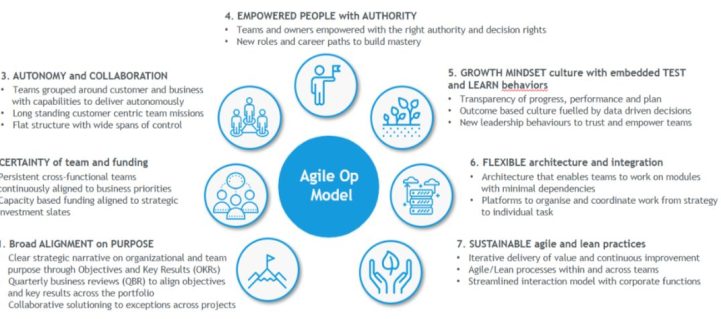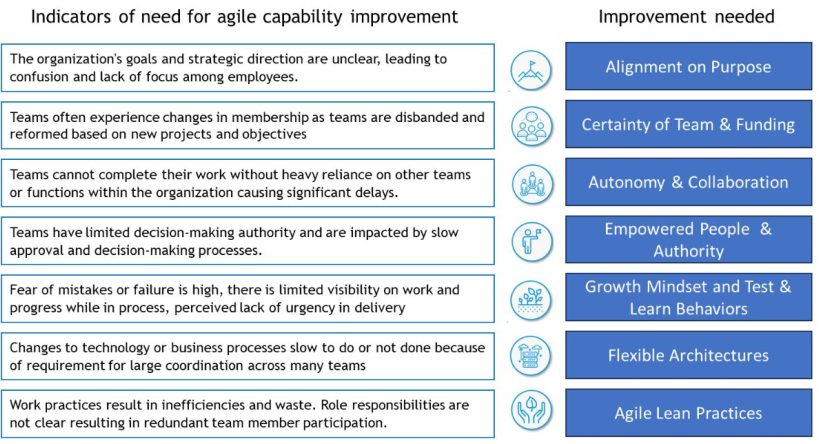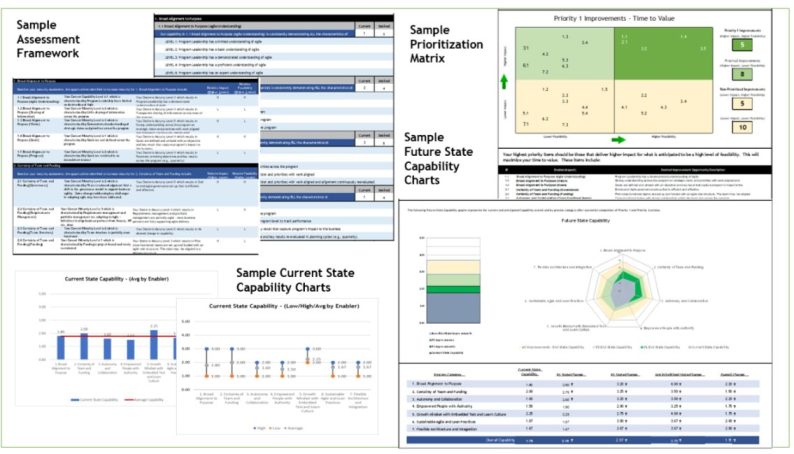Agile Ceremonies or True Business Agility; is it time for a Capability Assessment?
Are you building the right capabilities to realize the value of an Agile Organization?
In today’s dynamic business landscape, leading companies are turning to business agility with the promise of increased efficiency, enhanced responsiveness to customer needs, and improved business performance. To realize these benefits, the entire organization must respond to and embrace changes in mindsets, behaviors, and practices to help drive business value. When we think about the term “Agile”, too often it is misconstrued as processes and practices to get a product or service out the door faster. Whereas, Business Agility takes into account the larger enterprise, and the ability to sense and respond to change and new opportunities in a sustainable way through a shift in mindsets, culture, capabilities, systems and practices.
The full potential of business agility often remains untapped because organizations tend to focus on the mechanics of agile methodologies—the ceremonies, roles, and processes—while neglecting the broader, strategic aspects of business agility. True business agility is not merely about how teams conduct their daily stand-ups or manage their backlogs and sprints; it is about embedding the required values and principles at the core of the business strategy, culture, and operations to enable the commitment and achievement of goals. Business agility is what will deliver the promise of increased efficiency, enhanced responsiveness to customer needs, and improved business performance.
ADAPTOVATE’s framework for Business Agility
ADAPTOVATE guides organizations to achieve business agility by leveraging the 7 Enablers of Business Agility. (Figure 1). This framework for transformation has and is guiding the strategic imperatives of many of the world’s largest and most successful companies.
Figure 1: 7 Enablers of Business Agility

The 7 Enablers offer an operating model or blueprint for organizations to assess and enhance their agility. By examining the core aspects within each of the enablers, organizations can identify their current capabilities, prioritize key aspects to improve, and targeted actions to increase business agility.
Key aspects of the 7 Enablers of Business Agility
Organizations that believe they have reached business agility will demonstrate the key aspects defined in the ADAPTOVATE 7 Enablers of Business Agility. These aspects include:
- Alignment on Purpose – Everyone in the organization must understand and commit to the shared goals and objectives. For each objective, the specific result for success must be known. This requires clear communication of the company’s vision and strategic objectives and required key results.
- Certainty of Team and Funding – Teams must be resourced appropriately, and funding models need to support agile ways of working(i.e., funding the capacity of teams vs. funding projects). Teams should be persistent and working to deliver the highest business priorities.
- Autonomy and Collaboration – Teams should be structured around the customer and their business objectives. Teams should be self-governing and have the capabilities needed within their team to meet the objectives (i.e., autonomous). Teams should collaborate effectively and efficiently with each other and their stakeholders.
- Empowered People with Authority – To accelerate decision making and increase accountability, teams must be empowered to make the decisions needed. This will better enable team members to build mastery in their role and evolve their careers.
- Growth Mindset Culture – Team members must know that that leadership has trust in them. The organizational culture must embrace continuous learning and improvement. Correspondingly, “test and learn” behaviors should be encouraged. Transparency of work, progress, and focus on outcomes (i.e., successes and failures) must be prevalent.
- Flexible Architecture and Integration – These architectures must be defined and understood. Both the business and technology architectures must allow adaptation to support changes needed to meet objectives. They should not be intertwined in such a way that change requires resolving complex interdependencies in business process or system functions. Technology should be in place to organize and coordinate work from organizational strategy to the level of individual tasks.
- Sustainable Agile and Lean Practices – Agile practices and disciplines must be implemented and maintained to enable incremental and iterative delivery, continuous delivery of value, continuous improvement, streamlined interaction, and team efficiency. These lean practices must be applied not only within a team but across teams including corporate functions.
Is your organization “agile”?
Many organizations rely on telltale signs that they have are not operating with business agility. The following lists some of these signs and the improvement area needed.may include:
- The organization’s goals and strategic direction are unclear, leading to confusion and lack of focus among employees. (Indicating deficiencies in Alignment on Purpose.)
- Teams often experience changes in membership as teams are disbanded and reformed based on new projects and objectives. (Indicating deficiencies in Certainty of Team and Funding.)
- Teams cannot complete their work without heavy reliance on other teams or functions within the organization. A “request and fulfillment process” to authorize collaboration between teams is causing significant delays. (Indicating deficiencies in Autonomy and Collaboration.)
- Teams have limited decision-making authority and are impacted by slow approval and decision-making processes. (Indicating deficiencies in Empowerment and Authority.)
- There is much time spent trying to get work completely right the first time, fear of mistakes or failure is high, and there is limited visibility on work and progress while in process. (Indicating deficiencies in Growth mindset and a Test and Learn Culture.)
- Changes to technology and business processes require a large coordination with many affected teams and therefore, may not be able to be done or done efficiently. (Indicating deficiencies in a Flexible Architecture.)
- Work practices result in inefficiencies and waste. Delivery is not done efficiently, and success is often not predictable. Role responsibilities are not clear resulting in redundancy in team member participation in task assignments. (Indicating deficiencies in Lean Agile Practices).

Organizations recognize these indicators and know they are not realizing the benefits of agility. They recognize problems but do not have a systematic approach to identify solutions and priorities. They struggle to define an approach or roadmap to reach their business agility targets. The ADAPTOVATE Business Agility Quick Capability Assessment (QCA) can jumpstart the capabilities needed to reach your agility targets.
Using the ADAPTOVATE Business Agility Quick Capability Assessment (QCA) to help build your capability.
ADAPTOVATE’s Business Agility Quick Capability Assessment (QCA) provides its customers with the ability to identify and/or confirm the level of capability across the key enablers needed for business agility and help identify and prioritize opportunities for improvement. It provides a continuous improvement framework for customers to reach their desire level of business agility.
Typically, the QCA can be run in 3-4 hours and deliver the following outcomes:
- A Business Agility Framework to guide Improvement – An in-depth understanding of the 7 Enablers of Business Agility and the aspects that are achieved for an organization to realize full capability in business agility.
- An understanding of current capability – For each of the aspects defined within the 7 business agility enablers, an understanding of what level of capability their organization has reached consistently.
- A desired target state – For each of the aspects defined within the 7 business agility enablers, a desired target for next level capability and an understanding of the improvements that must be demonstrated to reach the desired level of capability.
- A prioritized list of improvements – Improvements for each target state prioritized in terms of impact to the business and feasibility of successful and timely implementation of change.
- A roadmap of improvement – For all high impact priorities, an incremental roadmap of actionable improvements to achieve expected outcomes and improve the organization’s business agility.
As a framework for continuous improvement, the Business Agility QCA can be repeated periodically to identify, prioritize, and plan the next set of high-priority improvements. The process can continue to iterate until the organization reaches its ultimate target for business agility across each of the 7 enablers.
The output of the QCA is a comprehensive deliverable containing the sample artifacts displayed in the follow graphic.
Sample artifacts of ADAPTOVATE Business Agility Quick Capability Assessment (QCA)

Ready to Navigate the Future with Improved Business Agility?
Contact ADAPTOVATE today and:
- Schedule your ADAPTOVATE Business Agility Quick Capability Assessment (QCA)
- Begin your journey to realize the value of business agility within your organization.
CONTACT INFORMATION
+1 424 543 2623
US Headquarters
695 Town Center Dr, Suite 1200
Costa Mesa, CA 92626
Locations
USA
AUSTRALIA & NEW ZEALAND
Sydney
Level 8/341 George St
Sydney NSW 2000
+61 2 7200 2530
Melbourne
Suite 22-125 120 Spencer Street,
Melbourne VIC 3000
+61 2 7200 2530
Canberra
Suite 3, Ground Floor/65 Canberra Ave
Griffith ACT 2603
+61 2 7200 2530
Auckland (Tāmaki Makaurau)
Level 4, ACS House, 3 Ferncroft Street,
Grafton, Auckland 1010
New Zealand
SINGAPORE
20 Collyer Quay, Level 12,
Singapore
+65 98348486
POLAND
ul. Czackiego 15/17
00 -043 Warszawa
+48 505 626 416
CANADA
Postal location:
110 Cumberland Street Suite # 307
Toronto ON M5R 3V5
Physical office location:
296 Richmond St. West
Toronto, ON M5V 1X2
Canada
+1 647 631 1205
UK
5th Floor, 167-169 Great Portland Street
London W1W 5PF
+44 20 3603 1662

Key Approaches
- Business Operating Model Design
- Training
- Agile Transformation
- Business Capability Mapping
- Business Transformations
- Digital Transformations
- Objective and Key Results (OKRs)
- Quarterly Delivery Cycle (QDC)
- Agile PMO
- Agile Procurement
- Exec and team coaching
- Human-Centred Design
- Process Improvement
- Value Stream Mapping
©2022 ADAPTOVATE. All rights reserved